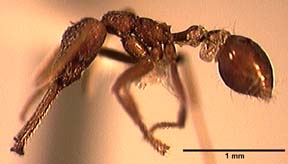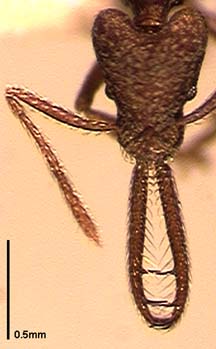Strumigenys deletrix Bolton ms
This manuscript name is a conditional proposal by B. Bolton (sensu Article 15 of the 1985 ICZN), and thus not made available here. Its appearance here or in any duplication of this page does not constitute publication (sensu Article 8 of the 1985 ICZN).
Dacetini, Myrmicinae, Formicidae, Hymenoptera, Insecta, Arthropoda, Animalia
John T. Longino, The Evergreen State College, Olympia WA 98505
USA. longinoj@evergreen.edu
21 August 1997

Specimen: Costa Rica, Prov. Puntarenas: 19km S. Ciudad Neily, 20m (J. Longino 2658-s). INBIOCRI001281636. Image by J. Longino.
|

Specimen: Costa Rica, Prov. Puntarenas: 19km S. Ciudad Neily, 20m (J. Longino 2658-s). INBIOCRI001281636. Image by J. Longino. |
Identification
Apical fork of mandible with a single intercalary tooth; mandible with two conspicuous preapical teeth; mandible extremely long, longer than head; gaster smooth and shiny; specialized humeral hair short, broadly spatulate, curved posteriorly and closely applied to the surface; dorsolateral margin of the head close to the apex of the scrobe without stiff projecting hair.
Head length 0.77mm, mandible length 0.82, CI 77, MI 106 (n=1).
Range
Costa Rica: southern Pacific lowlands (19km south Ciudad Neily).
Natural History
Brown and Wilson (1959) summarize the genus as follows:
"Widespread in tropics and warm temperate areas. Primarily forest-dwelling; some species occur in grassland and arid scrub. ... Nests mostly in soil and rotting wood; a few species live in arboreal plant cavities in tropical rain forest. Foraging hypogaeic to epigaeic-arboreal. Food: most species are collembolan feeders; a few are polyphagous predators or occasionally feed on sugary substances..."
Brown (1958) states that the extremely long mandibles of the very similar species cordovensis are possibly used
"to lift the prey, presumed to be mainly or entirely furculate collembolans as in other species of the genus, clear of the ground after the mandibular strike is made, in this way preventing the springtails from kicking with the furcula against the ground and upsetting the ant. Such disproportionately large mandibles must be employed almost entirely in the open, because confined spaces would surely hinder their action."
This species is known only from the types.
Selected Records
Winkler sample 19km S Ciudad Neily.
Literature Cited
Brown, W. L., Jr. 1958. The neotropical species of the ant genus Strumigenys Fr. Smith: Group of cordovensis Mayr. Studia Entomologica 1:217-224.
Brown, W. L., Jr. 1962. The neotropical species of the ant genus Strumigenys Fr. Smith: Synopsis and keys to the species. Psyche 69:238-267.
Brown, W. L., Jr., Wilson, E. O. 1959. The evolution of the dacetine ants. Quarterly Review of Biology 34:278-294.
Previous versions of this page:
 Go back to top
Go back to top

